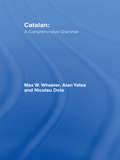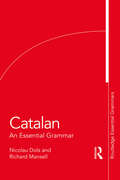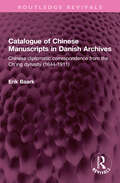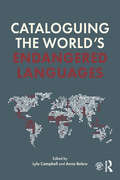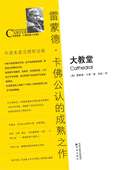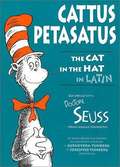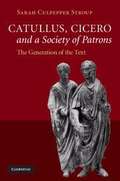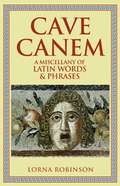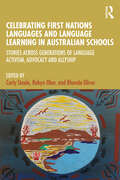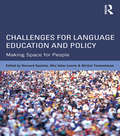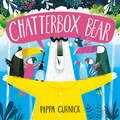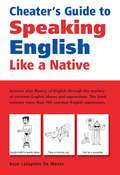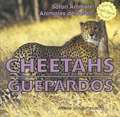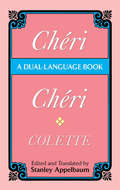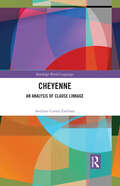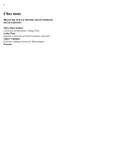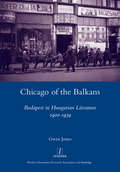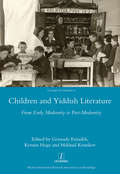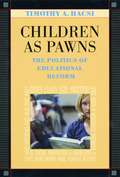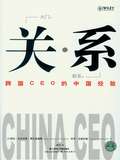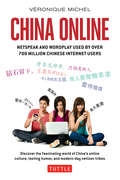- Table View
- List View
Catalan: A Comprehensive Grammar (Routledge Comprehensive Grammars)
by Max Wheeler Alan Yates Nicolau DolsCatalan: A Comprehensive Grammar is a complete reference guide to modern Catalan grammar, presenting an accessible and systematic description of the modern language. It is the only comprehensive grammar of the language available in EnglishThe Grammar reflects the current reality of Catalan by acknowledging regional diversity and features Balearic and Valencian varieties alongside the language used in the Barcelona region.The combined specialist knowledge of the author team ensures a balanced coverage of modern Catalan.Features include:* comprehensive coverage of all parts of speech* a wealth of authentic examples illustrating language points* attention to areas of particular difficulty for those whose first language is English* full cross-referencing* detailed index.
Catalan: An Essential Grammar (Routledge Comprehensive Grammars Ser.)
by Nicolau Dols Richard MansellCatalan: An Essential Grammar is a concise and convenient guide to the basic grammatical structure of Catalan. Presenting a fresh and accessible description of the language, this engaging Grammar uses clear explanations and sets out the complexities of Catalan in short, readable sections clarified by examples. Quick reference overviews are also provided in the appendix. Catalan: An Essential Grammar is the ideal reference grammar for all learners of Catalan, whether class-based or independent, looking to progress beyond beginner level.
Catalogue of Chinese Manuscripts in Danish Archives: Chinese diplomatic correspondence from the Ch'ing dynasty (1644-1911) (Routledge Revivals)
by Erik BaarkFirst published in 1980, Catalogue of Chinese Manuscripts in Danish Archives is a descriptive catalogue that gives the date, address, and a summary of the contents for some 500 Chinese manuscripts in three Danish archives: the National Archives, the National Museum, and the Archives of the Great Northern Telegraph Company. The Chinese diplomatic correspondence kept in these archives form important source material for the study of Sino-Danish relations in the nineteenth century. In addition, the contents of the manuscripts shed an interesting light on the way Chinese and foreign diplomacy at the lowest level was conducted during the crucial years of Sino-Western relations. The book contains an introduction and two indexes, one for the names mentioned in the addresses, and one for the subjects and names mentioned in the summaries. The book will appeal to students of history, political science, international relations and diplomacy.
Cataloguing the World's Endangered Languages
by Lyle Campbell Anna BelewCataloguing the World’s Endangered Languages brings together the results of the extensive and influential Catalogue of Endangered Languages (ELCat) project. Based on the findings from the most extensive endangered languages research project, this is the most comprehensive source of accurate information on endangered languages. The book presents the academic and scientific findings that underpin the online Catalogue, located at www.endangeredlanguages.com, making it an essential companion to the website for academics and researchers working in this area. While the online Catalogue displays much data from the ELCat project, this volume develops and emphasizes aspects of the research behind the data and includes topics of great interest in the field, not previously covered in a single volume. Cataloguing the World’s Endangered Languages is an important volume of particular interest to academics and researchers working with endangered languages.
Cathedral (Mandarin Edition)
by Raymond CarverCathedral is a collection of short stories that overflow with the danger, excitement, mystery and possibility of life. These similar stories, very skillful within their narrow limits, were written with a dry intensity, and moving, at their climaxes, from the commonplace to the unnerving.雷蒙德·卡弗是近年美国杰出的短篇小说家 六七十年代的美国社会动荡,思潮澎湃 作者从忧患困顿中脱颖而出 十年间发表了好几部集子 都属畅销 他的作品写的几乎全是社会中下阶层 失业无告 婚变心碎 贫病自弃之人 写作手法也颇为独特 人称"极简派"或"峻削派" 其作品曾多次获奖 屡屡被选做经典语文读本 并被译成二十多种文字 大教堂 是卡佛的短篇小说集 1983年出版后,日文版和英国版随即出版并被提名普利策奖 本书中文译本是首次授权出版,由青年作家,芝加哥大学文学博士肖铁倾心翻译
Cattus Petasatus: The Cat in the Hat in Latin
by Jennifer Morrish Tunberg Terence Tunberg SeussIncludes a Latin-English glossary and a note on the verse form and rhythm.
Catullus, Cicero, and a Society of Patrons
by Sarah Culpepper StroupThis is a study of the emergence, development, and florescence of a distinctly 'late Republican' socio-textual culture as recorded in the writings of this period's two most influential authors, Catullus and Cicero. It reveals a multi-faceted textual - rather than more traditionally-defined 'literary' - world that both defines the intellectual life of the late Republic, and lays the foundations for those authors of the Principate and Empire who identified this period as their literary source and inspiration. By first questioning, and then rejecting, the traditional polarisation of Catullus and Cicero, and by broadening the scope of late Republican socio-literary studies to include intersections of language, social practice, and textual materiality, this book presents a fresh picture of both the socio-textual world of the late Republic and the primary authors through whom this world would gain renown.
Cave Canem: A Miscellany of Latin Words and Phrases
by Lorna Robinson"Latin may be called a dead language, but it is currently experiencing a renaissance. In this spirit, Oxford-trained classicist Lorna Robinson introduces readers to the wonderful, chimeric world of the Latin language--and what better forum for this than the world of ancient Rome, where Latin flowered and expanded with the Roman Empire to become Europe's dominant language." -Back Cover
Celebrating First Nations Languages and Language Learning in Australian Schools: Stories Across Generations of Language Activism, Advocacy and Allyship
by Rhonda Oliver Carly Steele Robyn OberThis book introduces key underlying principles for teaching First Nations languages and language learners in schools across a range of contexts. It takes a comprehensive approach covering traditional languages, new languages, and English.At a critical time for Indigenous languages across the globe, the United Nations Decade of Indigenous Languages (2022–2032) draws attention to the endangerment of these languages and advocates for the role of education to preserve and revitalise Indigenous languages. At the same time, many new language varieties spoken by Indigenous peoples often remain unrecognised in education systems, and their English language learning needs are left unaddressed. This book provides crucial information to enhance the reader’s knowledge of these critical issues in language and education with a view to promote future action. The chapters showcase the advocacy, activism, and allyship for First Nations languages and language learners undertaken by educators, education systems, and researchers in Australia. With a practical focus, this book illustrates innovative and contemporary approaches to language learning for First Nations students; educators can use this text to guide and develop language-learning approaches in their respective contexts.This is a foundational resource for both Indigenous and non-Indigenous teachers and aspiring teachers alike, and all education professionals who appreciate the fundamental importance of language in education.
Cemetery of Untold Stories \ El cementerio de los cuentos sin contar Sp. ed.
by Julia AlvarezLa inigualable Julia Alvarez, autora de En el tiempo de las mariposas y De cómo las muchachas García perdieron el acento, regresa con una extraordinaria e íntima novela que nos recuerda que las historias de vida jamás están realmente acabadas. Ni siquiera cuando llega el final.**Uno de los libros más esperados del año según el New York Times, Washington Post, Today.com, Goodreads, Literary Hub, BookPage, BBC.com, and Zibby Mag**Alma Cruz ha decidido ponerle punto final a su carrera de escritora, pero teme acabar como su amiga, una exitosa novelista arrastrada a la locura por un libro que jamás terminó de escribir. Por eso, cuando hereda un modesto terreno en República Dominicana, se le ocurre sepultar allí sus decenas de manuscritos inconclusos. Quiere que descansen en paz en la misma tierra donde yacen sus raíces.Pero a diferencia de Alma, los protagonistas de sus relatos aún tienen mucho por decir, y encuentran en Filomena, la reservada cuidadora del cementerio, una interlocutora empática y atenta. Al compartir sus historiasBienvenida, la exesposa olvidada del dictador Rafael Trujillo; Manuel Cruz, un médico exiliado durante el régimen, y la misma Filomena convertirán el cementerio en un lugar mágico.Un santuario donde quienes han sido silenciados hallarán el sentido que anhelan en la vitalidad imperecedera de los cuentos que aún quedan por contar.Y colorín colorado...——Literary icon Julia Alvarez, bestselling author of In the Time of the Butterflies, shares an inventive and emotional novel about storytelling and her homeland—the Dominican Republic—that Kirkus Reviews calls a "rich and moving saga" and Shelf Awareness calls "a lyrical thought-provoking meditation on truth, complicated family narratives, and the question of whose stories get told." **Named a Most Anticipated Book of the Year by the New York Times, Washington Post, Today.com, Goodreads, Literary Hub, BookPage, BBC.com, and Zibby Mag**Alma Cruz has decided to end her writing career, but she fears she'll end up like her friend, a successful novelist driven to madness by a book she never finished writing. So when she inherits a modest plot of land in the Dominican Republic, she decides to bury her dozens of unfinished manuscripts there. She wants them to rest in peace in the same land where her roots are. But unlike Alma, the protagonists of her stories still have plenty to say, and they find in Filomena, the reserved caretaker of the cemetery, an empathetic and attentive interlocutor. By sharing their stories, Bienvenida, the forgotten ex-wife of dictator Rafael Trujillo; Manuel Cruz, a doctor exiled during the regime, and Filomena herself will turn the cemetery into a magical place, a sanctuary where those who have been silenced will find the meaning they yearn for in the imperishable vitality of the untold stories.Y colorín colorado...
Challenges for Language Education and Policy: Making Space for People
by Bernard Spolsky Ofra Inbar-Lourie Michal TannenbaumAddressing a wide range of issues in applied linguistics, sociolinguistics, and multilingualism, this volume focuses on language users, the ‘people.’ Making creative connections between existing scholarship in language policy and contemporary theory and research in other social sciences, authors from around the world offer new critical perspectives for analyzing language phenomena and language theories, suggesting new meeting points among language users and language policy makers, norms, and traditions in diverse cultural, geographical, and historical contexts. Identifying and expanding on previously neglected aspects of language studies, the book is inspired by the work of Elana Shohamy, whose critical view and innovative work on a broad spectrum of key topics in applied linguistics has influenced many scholars in the field to think “out of the box” and to reconsider some basic commonly held understandings, specifically with regard to the impact of language and languaging on individual language users rather than on the masses.
Chatterbox Bear
by Pippa CurnickMeet Gary the bear - he just can't stop chatting! A laugh-out-loud-funny story about friendship and understanding.Gary the bear is a chatterbox, but when nobody wants to listen he sets sail in search of new friends. Soon Gary arrives on an island full of birds . . . the problem is they don't understand a word of Bear! Gary has to learn that words are not the only way to communicate and make new friends.This sunny and bright picture book is bursting with energy and humour.From the illustrator of Lucie Goose, shortlisted for the Evening Standard Oscar's First Book Prize.
Cheater's Guide to Speaking English Like a Native
by Boye Lafayette De MenteIncrease your fluency of English through the mastery of common English idioms and expressions.All Native English-speakers use a large number of proverbs and colloquial expressions in their daily conversations. These common sayings, which evolved over the centuries, are like "codes" that reveal the cultural values and attitudes of the speakers.To obtain complete fluency in the English language it is necessary to be familiar with these expressions and know how and when to use them.With a user-friendly format, The Cheater's Guide to Speaking English like a Native is a shortcut to achieving that goal.
Cheers!: Around the World in 80 Toasts
by Brandon CookSalut! Prost! Skål! Na zdrave! Tagay! No matter what country you clink glasses in, everyone has a word for cheers. In Cheers! Around the World in 80 Toasts, Brandon Cook takes readers on a whirlwind trip through languages from Estonian to Elvish and everywhere in between. Need to know how to toast in Tagalog? Say "bottoms up" in Basque? "Down the hatch" in Hungarian? Cook teaches readers how to toast in 80 languages and includes drinking traditions, historical facts, and strange linguistic phenomena for each. Sweden, for instance, has a drinking song that taunts an uppity garden gnome, while Turkey brandishes words like Avrupalılaştıramadıklarımızdanmışsınızcasına. And the most valuable liquor brand in the world isn't Johnny Walker or Hennessey, but Maotai—President Nixon's liquor of choice when he visited China. Whether you're traveling the globe or the beer aisle, Cheers! will show you there's a world of fun waiting for you. So raise a glass and begin exploring!
Cheetahs Guepardos
by Amelie Von Zumbusch Pilar SanzSimple bilingual English/Spanish text will captivate English language learners as they focus on the habitats, behaviors, and physical adaptations of the cheetah.
Cheri (Dual-Language)
by Colette Stanley AppelbaumSidonie-Gabrielle Colette (1873-1954), one of the most popular and best loved of modern French writers, became known simply as Colette when she married in 1893. Her husband, a Parisian man-about-town and the son of a major publisher, made use of her literary talents by publishing her first several novels under his own name -- his only changes, evidently, being to make them more prurient. But eventually she broke free of this unhappy marriage and took flight on her own, as a fiction writer, a journalist, and an actress. By the time Chéri was published in 1920, Colette had become well known both as a writer and as a personality and was entering a period of rich personal growth and happiness.Published when the author, like her heroine, was in her late 40s, Chéri is a delicate analysis of a May-December romance. The story of a love affair between Léa, a still-beautiful 49-year-old ex-courtesan, and Chéri, a handsome but selfish young man 30 years her junior, it offers a superb study of age and sexuality, written in a personal style that reveals the author's keen powers of observation. While the theme of a young man who deserts his older mistress is a familiar one, in this novel, Colette makes it her own. As Stanley Appelbaum notes, "Colette's distinctive style, made up of swift, sure, almost impressionistic touches, and the skillful use of leitmotifs, enables her to create her own atmosphere and her own emotional universe."Widely considered the author's best work, the novel appears here in the original French with an excellent new English translation by Stanley Appelbaum on the facing pages. The translator also has provided an informative introduction to Colette and her work, and to this novel in particular.
Cheyenne: An Analysis of Clause Linkage (Routledge World Languages)
by Avelino Corral EstebanCheyenne: An Analysis of Clause Linkage provides a detailed description of Cheyenne syntax, semantics, and pragmatics, notably on its nominal and verbal system and in both simple and complex sentences. Based on fieldwork conducted on the Northern Cheyenne reservation, this book, which seeks to address descriptive and theoretical issues involving complex sentences, has three major aims: i) to present a morpho-syntactic, semantic, and discourse-pragmatic description of complex sentences in Cheyenne; ii) to investigate the relationship between the semantic and syntactic dimensions of complex sentences; and iii) to contribute to the research, preservation, and revitalization of this ancestral language spoken in the United States of America. This book will be informative for scholars interested in language typology, comparative linguistics, theoretical linguistics, and language documentation, as well as those interested in Cheyenne learning and teaching.
Chez Nous: Branché Sur Le Monde Francophone
by Albert Valdman Cathy Pons Mary Ellen ScullenChez nous: Branché sur le monde francophone offers a flexible, dynamic approach to elementary French that engages students by bringing the French language and the culture of French-speaking people to life. Authors Mary Ellen Scullen, Cathy Pons, and Albert Valdman help students achieve grammatical and communicative competence through pertinent, well-sequenced themes, carefully designed presentations of important structures, and a wealth of opportunities for meaningful student practice. The 5th Edition offers significantly updated content, including coverage of contemporary topics about which students will be excited to converse, as well as a modern, engaging design.
Chicago of the Balkans: Budapest in Hungarian Literature 1900-1939
by Gwen JonesAt the point of its creation in 1873, Budapest was intended to be a pleasant rallying point of orderliness, high culture and elevated social principles: the jewel in the national crown. From the turn of the century to World War II, however, the Hungarian capital was described, variously, as: Judapest, the sinful city, not in Hungary, and the Chicago of the Balkans. This is the first English-language study of competing metropolitan narratives in Hungarian literature that spans both the liberal late Habsburg and post-liberal, 'Christian-national' eras, at the same time as the 'Jewish Question' became increasingly inseparable from representations of the city. Works by writers from a wide variety of backgrounds are discussed, from Jewish satirists to icons of the radical Right, representatives of conservative national schools, and modernist, avant-garde and 'peasantist' authors. Gwen Jones is Hon. Research Associate at the Department of Hebrew and Jewish Studies, University College London.
Children Learning Second Languages
by Annamaria PinterChildren Learning Second Languages is a four-partcomprehensive guide to current research and debate related to second language learning in childhood, the age factor and the relationship between research and classroom practice. Part 1 covers child development, L1 and L2 language learning processes in childhood and offers a guide to contexts from foreign language learning at school to immersion education and bilingual/trilingual acquisition at home. Part 2 gives a bird's eye view of current research in the area of child SLA and pedagogy highlighting the strengths and weaknesses of different traditions and types of research. This is followed by a close examination of eight case studies. Part 3 is devoted to issues of future research priorities by discussing methodological and ethical difficulties in child focused research and outlining 15 feasible studies for the future. Part 4 offers some resources including hands-on teaching materials, handbooks, theoretical books, details of organizations and projects in the broad area of child second language learning. "
Children and Yiddish Literature From Early Modernity to Post-Modernity: From Early Modernity To Post-modernity (Legenda Ser.)
by Gennady Estraikh Kerstin Hoge Krutikov MikhailChildren have occupied a prominent place in Yiddish literature since early modern times, but children’s literature as a genre has its beginnings in the early 20th century. Its emergence reflected the desire of Jewish intellectuals to introduce modern forms of education, and promote ideological agendas, both in Eastern Europe and in immigrant communities elsewhere. Before the Second World War, a number of publishing houses and periodicals in Europe and the Americas specialized in stories, novels and poems for various age groups. Prominent authors such as Yankev Glatshteyn, Der Nister, Joseph Opatoshu, Leyb Kvitko, made original contributions to the genre, while artists, such as Marc Chagall, El Lissitzky and Yisakhar Ber Rybak, also took an active part. In the Soviet Union, meanwhile, children’s literature provided an opportunity to escape strong ideological pressure. Yiddish children’s literature is still being produced today, both for secular and strongly Orthodox communities. This volume is a pioneering collective study not only of children’s literature but of the role played by children in literature.
Children as Pawns: The Politics of Educational Reform
by Timothy A. HacsiHead Start. Bilingual education. Small class size. Social promotion. School funding. Virtually every school system in America has had to face these issues over the past thirty years. Advocates and dissenters have declared confidently that "the research" is on their side. But is it? In the first book to bring together the recent history of educational policy and politics with the research evidence, Timothy Hacsi presents the illuminating, often-forgotten stories of these five controversial topics. He sifts through the complicated evaluation research literature and compares the policies that have been adopted to the best evidence about what actually works. He lucidly explains what the major studies show, what they don't, and how they have been misunderstood and misrepresented. Hacsi shows how rarely educational policies are based on solid research evidence, and how programs that sound plausible simply do not satisfy the complex needs of real children.
China CEO: Voices of Experience from 20 International Business Leaders (Mandarin Edition)
by Juan FernandezCHINA CEO: Voices of Experience From 20 International Business Leaders is based on interviews with 20 top executives and eight experienced consultants based in China. The book is packed with first-hand, front-line advice from veterans of the China market. Hear directly from the top executives heading up the China operations of Bayer, British Petroleum, Coca-Cola, General Electric, General Motors, Philips, Microsoft, Siemens, Sony and Unilever, plus expert China-based consultants at Boston Consulting Group, Korn/Ferry International, McKinsey & Company, and many more. Each chapter provides practical tips and easy to grasp models that will help new managers in China to be effective. In CHINA CEO, we deliver what other Western authors can't - first-hand reflections based on over 100 years' collective experience in China. The book presents this rich knowledge in a readable, conversational style suitable for time-constrained executives. Each chapter gives specific advice on how to manage Chinese employees, work with Chinese business partners, communicate with headquarters, face competitors, battle intellectual property rights infringers, win-over Chinese consumers, negotiate with the Chinese government, and adapt yourself (and your family) to life in China.关系指人和人或人和事物之间的某种性质的联系 比如拉关系,社会关系等 事实上 "关系"并不像西方人有时想象的那样 本身就是不道德的 "关系"体制也并不意味着 公司在行贿或者达成私下交易后就可以为所欲为 不过 与西方国家相比 中国的商业伙伴往往会发展出更加密切和深入的关系 国际经理人常常会发现自己在中国开展正常业务时 往往是在一个充满人情且依靠个人 而非职业 能力的环境中行事
China Online
by Véronique Michel Sebastien Koval Claude Muller Marcio LoboDive into China's cool new web-based subculture with China Online!Using Baidu, China's form of Google, young Chinese web-surfers are creating their own language on the Internet. With this book, you can get an insider's view of the way the new wave of Chinese youth communicates in code. Author and translator Véronique Michel guides you on a tour of the lifestyles inhabiting modern-day "tribes" on the Internet: The "Moonlight" or "Starlight" TribeThe "Ant" TribeThe "Corporate Insects"The "Diamond Man"China Online describes a youth culture in transition-using humor and creativity to survive in a hugely competitive environment. They enjoy pun-including the ingenious "talking numbers" used to say more things with fewer keystrokes and characters. There is a great deal that lies under the surface. Learn the secret netspeak used by over half a billion of the coolest people in China, and be in the know!
